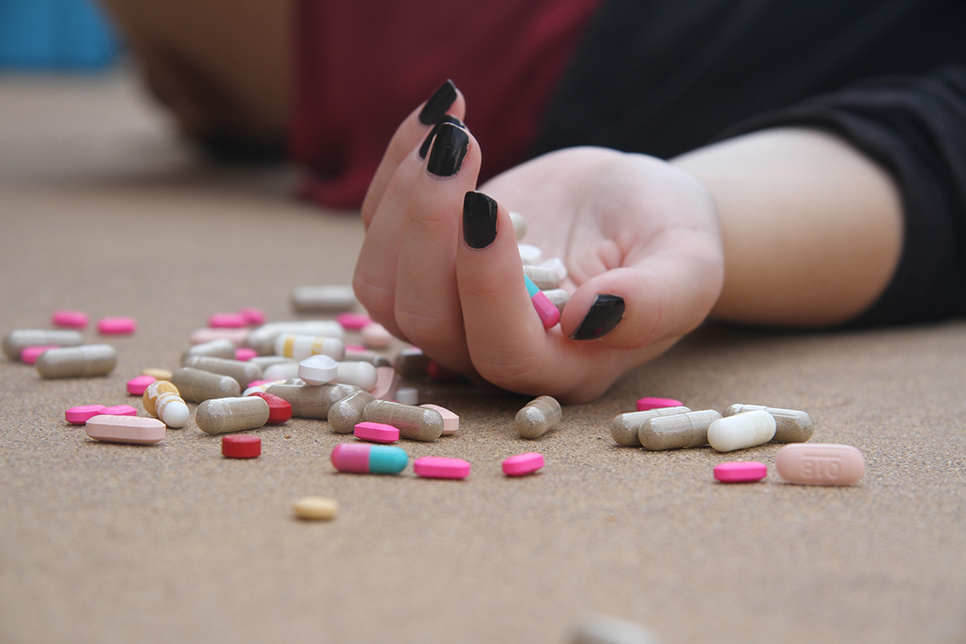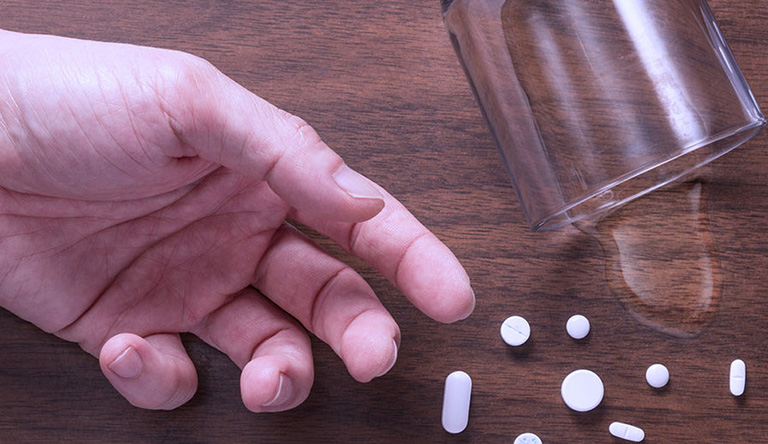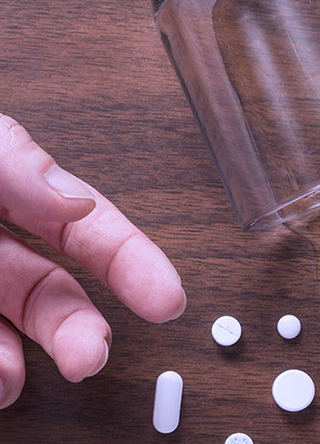Teen drug overdose has evolved into a national problem in the United States. As a parent, if you are worried about the possibility of your teenager overdosing, you are not alone. Although many teen drug overdoses are the result of long-term drug abuse and addiction, an equal number are caused by first-time experimentation. When a teenager decides to try hard drugs, heroin overdose, prescription drug overdose, cocaine overdose, or many other kinds of drug overdose are often the tragic result.
Even worse, although some teen drug overdoses lead only to temporary hospitalization, many more result in the true heartbreak of a teen drug overdose death. Such a death from drug abuse can destroy a family, leaving behind a gaping hole of sorrow and devastation. Indeed, the lives of our nation’s teenagers are our future. Hence, teenagers need to be protected from a drug overdose at all costs.
What Is a Drug Overdose?
his is a good question that deserves careful examination. Since many parents and caregivers do not have experience with drug abuse and drug addiction, they do not know about drug overdose beyond the headlines. First, it’s important to know that drug overdoses can be accidental or intentional. For example, intentional drug overdoses tend to be seen as a suicide attempt. As horrible as they are, such overdoses are in the minority. If a person survives, an intentional drug overdose often requires immediate hospitalization, psychiatric help, and professional support.
An accidental drug overdose happens when a person takes more than the medically recommended dosage of a drug. In the case of illegal drugs that are used to get high, substances like heroin or cocaine often are taken in overdose amounts by accident. A heroin overdose or cocaine overdose occurs when a teenager’s metabolism cannot detoxify the drug fast enough to avoid unintended, often catastrophic, side effects.
Moreover, drug overdoses can happen when a teenager unexpectedly has a low tolerance to a new drug or illicit substance. A person’s reaction to a drug can be unique to them. Indeed, some teens are more sensitive than normal to certain drugs. Thus, a drug dosage that is within the normative range of acceptability or a typical dose of an illegal drug may prove to be too much for their bodies to handle. Hence, teen drug overdose happens unexpectedly.
According to the Centers for Disease Control and Prevention (CDC), 105 people in the United States die every day from drug overdose.
Teen Drug Overdose Rising
When it comes to the danger to your teenager, the latest statistics are frightening. They show that teen drug overdose deaths increased by almost 20% from 2014 to 2015. Released by the National Center for Health Statistics, a division of the Centers for Disease Control and Prevention, this statistic alone should be a resounding wake-up call to parents nationwide.
However, the problem is that teen drug overdose statistics take almost a year or more to compile. Indeed, since the data includes information from hospitals, mortuaries, law enforcement agencies, and more, it’s not easy to access. Once accessed, such data must be compiled. Hence, the most recent mortality and population data are from the National Center for Health Statistics’ 1999–2015 multiple cause-of-death mortality files.
Given the current trends, teens are being hit hard by the national opioid epidemic. At the same time, heroin use tends to go hand-in-hand with cocaine use. If you open the door to hard drugs, more than one is going to “crash the party.” Thus, heroin overdose and cocaine overdose or crack cocaine overdose are becoming more common. The difference is the danger levels of such overdoses. Although deaths occur with a cocaine overdose, heroin overdose fatality levels are much higher.

Future Drug Overdose Statistics Even Worse
Despite the information not yet available, it’s believed by many that the drug overdose data for 2016 will be even higher. Indeed, in light of what has happened so far in 2017, the teen drug overdose rates will surely climb again. Reflecting trends in the adult population, teenagers are taking risks with both illegal drug abuse and prescription drug misuse that would have seemed crazy a mere decade ago.
Overall, when you delve into the teen drug overdose statistics, there is so much that is revealed beyond the risk. Of course, the recent jump in teen overdose deaths is hard even to comprehend. However, it’s also essential to see how the increases are affecting both sexes. Thus, the teen overdose problem has been dramatically increasing more in the adolescent female population. Most likely, this is because teen girls are willing to take more chances in a drug culture where heroin and prescription medications are more widely accepted as viable substances to misuse and abuse.
Moreover, the willingness of teenagers today to consider experimenting with hard drugs is at the root of the problem. Surprisingly, both girls and boys are willing to consider the option of trying hard drugs. Given the teen overdose dangers by any first-time user of opioids and many other drugs, such a willingness is like a teen accepting a dance with the grim reaper.
Teen Drug Overdose Statistics
Let’s take a deeper look at statistics compiled by the CDC and other researchers nationwide.
+15%
Between 2013 and 2015, the number of teen boys dying from a drug overdose increased 15%
+35%
Between 2013 and 2015, the number of teen girls dying from a drug overdose increased 35%
70%
Despite the above increases, the drug overdose death rate for teen males was 70% higher than for teen females in 2015
2x
The death rate due to drug overdose among adolescents aged 15 to 19 has more than doubled since 1999
40%
40% of high school seniors believe it’s not harmful to try heroin
50%
50% of high school seniors do not think it’s harmful to try cocaine or crack cocaine once or twice
Teen Overdose Risk Beyond Heroin Overdose
The teen overdose risk goes well beyond heroin overdose. Although heroin overdose leads the charge of opioid overdoses, prescription opioid overdose and synthetic fentanyl overdose are closing the gap. Moreover, since most of the above statistics are fueled by the current opioid epidemic, a mistake that often is made is to ignore the other drug problems. However, prescription drug abuse beyond the opioids is a huge problem as well. Benzodiazepines and prescription tranquilizers like Valium and Xanax are dangerous and cannot be overlooked.
Moreover, a major problem is the tendency of teens to mix and match their drugs. Although they might not take enough of one drug to overdose, when combined with another, that is not the case, and the results are often deadly. As you well know as a parent, teenagers have a poor sense of their mortality. They do not comprehend the terrifying risks they are taking when they experiment with drugs and alcohol. Thus, even in the experimentation stage, teens cross the line, often unknowingly, leading to serious health risks and teen drug overdose.
In fact, one of the biggest dangers comes when drugs are mixed with alcohol. Hence, when drinking is thrown into the mix, the likelihood of teen drug overdose skyrockets. Since alcohol is a depressant, it bolsters the power of other central nervous system (CNS) depressants. The simple truth is mixing alcohol consumption with any form of drug abuse is like playing Russian Roulette. You never know when the next gun chamber will contain that one fatal bullet.
The recent increase in drug overdose deaths in 2015 came after several years of decline from 2007 to 2014.
Risk Factors for a Teen Drug Overdose
Although the specific risk factors for a drug overdose depend to some degree on the specific drug being used, there are general risk factors for drugs across the board. Hence, teens should be made aware of these risk factors. Indeed, understanding the dangers often is a form of prevention. By developing an awareness about the risk factors for a drug overdose, the deadly symptoms of a drug overdose might be avoided down the line.
The generalized risk factors for a teen drug overdose include:
- Lack of Drug Tolerance
When a drug is first taken, a person lacks a tolerance to the drug. This applies especially to opioids. If a first-time heroin user tries to inject the same amount as a long-time addict, they will experience a heroin overdose. Moreover, teens lack an understanding of how much to take. For example, prescription drug overdoses often were connected to time-release capsules. Since a teenager is not getting high because of the time-release formula, they take more and more. When all the prescription medication releases at once, the tragic result is a drug overdose.
- Relapsing After Being Sober
In recovery programs across the country, tragic circumstances unfortunately abound. For example, it is all-too-common that drug users trying to get sober overdose and die during a relapse. This is particularly true of a heroin overdose. When a teen heroin addict relapses after a period of sobriety, their tolerance to the drug has been significantly reduced by their time sober. During treatment, the detox process greatly reduces their tolerance to drugs. When they relapse on their drug of choice, they shoot their old “load.” This is the slang description for the amount they needed to get high before the period of recovery. Since their tolerance has gone down, their old load is extremely hazardous, leading to heroin overdose deaths. The irony and the tragedy is that these people were trying to get sober. This is why so many drug overdoses happen when people leave treatment.
- Methods of Using Drugs
Drug addicts are well-known for using prescription drugs in ways that they are not meant to be used. They crush up pills so they can be snorted or injected. Both of these methods of use lead to a more rapid onset of effects. In other words, they get high faster. However, such methods often lead to teen drug overdose because the dosages are approximated and the amount needed is often hard to calculate correctly.
- Mixing Substances/Drugs
Combining any two different drugs, whether prescription or illegal, always is a risky path to take. Such combinations of drugs may increase the risk of overdose, especially when two central nervous system depressants are taken together. The problem is that CNS depressants are common. For example, alcohol, opioids, and benzodiazepines are all CNS depressants, yet they are all combined on a regular basis by teenagers. With teenagers, the mixing of CNS depressants is one of the easiest and most common methods that lead to an unintentional drug overdose.

Signs of an Overdose — Heroin and Opioids
Given the dangers, parents need to know the signs of an overdose, particularly when it comes to heroin overdose and opioids across the board. When teenagers take a higher dose of heroin or an opioid painkiller than their body and brain can manage, the result often is a drug overdose. Since a heroin overdose is so often life-threatening, knowing the signs in advance can save a life.
If you suspect a heroin overdose, do not hesitate. Please seek professional medical help immediately if a heroin overdose is suspected. The best way to identify a heroin overdose is by looking for the three key symptoms. These three key symptoms are called the “opioid overdose triad” by the international medical community.
- Pinpoint pupils
- Slowed or stopped breathing / respiratory depression
- Unconsciousness / non-responsiveness
Respiratory depression combined with unconsciousness is a recipe for disaster. These ultra-dangerous symptoms of a heroin overdose can lead to hypoxia, or inadequate blood oxygenation. By cutting off oxygen to the brain, the heroin overdose suffocates the teenager, causing permanent brain damage or death.
Combined with the slowing or even stopping of a teen’s heart rate, the high fatality rates from heroin overdoses suddenly become a lot less surprising.
Although awareness of the opioid overdose triad is essential, there also are other symptoms that you can look for to correctly identify a heroin overdose:
- Limp body and loss of physical control
- Pale face and color drained from the cheeks
- Clammy skin and the lowering of the body temperature
- Purplish or bluish color to lips and fingernails
If any of these symptoms of an overdose are present in a teenager using opioids, please seek emergency medical help immediately.
Teen deaths from drug abuse now outnumber teen deaths from traffic accidents in the United States.
How to Respond to a Heroin Overdose
If a heroin overdose is suspected and you do not have access to the opioid antagonist naloxone (more about naloxone later), you need to call 911 for emergency medical assistance immediately. Please do not wait and consider your options. There surely are no other options when it comes to a heroin overdose. If medical treatment is not administered right away, death is an all-too-common outcome. Do not wait to seek help.
While waiting for emergency help to arrive, close monitoring of the teen overdose victim is a necessity. A teen suffering from a heroin overdose should be kept, if possible, awake and upright in a safe place. If respiratory depression has occurred and their breathing is slowing down or even stopped, CPR, preferably by a trained individual, needs to be performed right away.
Do your best not to let a teenager slip into unconsciousness while waiting for help to arrive. Once a medical team arrives, tell them everything that you know from what drug the teenager took to what has happened since the overdose was discovered. The more they know, the faster they can take the appropriate treatment action.
The medical team will examine and monitor the vital signs of a teenager, like heart rate, blood pressure, and temperature, to professionally assess the situation. Although the opioid antagonist naloxone can help, it is not always needed. In severe cases, naloxone, a medication used as an “antidote” to reverse many of the dangerous opioid effects, will be used by professionals. Since becoming a staple of the ambulances and paramedics, naloxone has saved thousands of lives nationwide.
More About Naloxone and a Heroin Overdose
A medication specifically designed to rapidly reverse opioid overdose, naloxone, often known by the brand name NARCAN®, is a chemical compound that works as an opioid antagonist. An opioid antagonist means that naloxone binds to opioid receptors in the central nervous system and the brain, reversing and blocking the effects of opioids. Almost miraculously, a dosage of naloxone can very quickly restore normal respiration to a person whose breathing has slowed or stopped as a result of overdosing on heroin or prescription opioid pain medications.
Naloxone is administered in three different ways. The evolution of the administration of the drug makes it surprisingly easy to use. Moreover, although it is a prescription drug, it can be accessed in many states without a prescription.
Naloxone methods of administration include:
- Injectable (professional training required).
Generic brands of injectable naloxone vials are listed in the FDA Orange Book – a compilation of approved drugs – under “naloxone.” However, beyond emergency circumstances, only trained medical professionals should employ this method. Emergency technicians often combine the injectable formulation of naloxone with an atomizer that can deliver naloxone intranasally. - Auto-Injectable.
EVZIO® is a prefilled auto-injector of naloxone that has been approved by the FDA. Unlike the regular injections, the auto-injector makes it easier for non-trained individuals to use naloxone quickly. According to FDA.gov, “Evzio is the first auto-injector designed to deliver a dose of naloxone outside of a health care setting”. It is designed to be used in the outer thigh. Once activated, like automated defibrillators, the device provides verbal instruction that explains how to deliver the medication. - Prepackaged Nasal Spray.
The latest technological development, NARCAN® Nasal Spray is a prefilled, needle-free device that requires no assembly. Very easy to use, the dosage is sprayed into one nostril while a teenager lays on his or her back.
The majority of adolescent drug overdose deaths in 2015 for both males and females were unintentional.
Naloxone Makes Sense for Parents
It makes a lot of sense for parents worried about the drug experimentation and possible abuse of their teenagers to keep naloxone in their home. When it comes to a heroin overdose, it’s always better to be safe than sorry. Naloxone can turn a potential tragedy into an opportunity for recovery.
Packaged in a carton containing two doses to allow for repeat dosing when needed, both NARCAN® Nasal Spray and EVZIO® are easy to utilize in emergency situations. They are both designed for home use and now can be bought at Walgreens or CVS in many states. A naloxone dose varies depending on the formulation. As a result, often more than one dose is needed to help a teen start breathing again.
However, the successful use of naloxone to revive a teenager is not the end of the crisis. If revived, a teen given naloxone should be carefully observed. Even if they are revived, emergency care is still required. If the decision is made by trained professionals not to take them to the hospital, observation for at least two hours is required post-administration of any of the naloxone formulations.
Moreover, naloxone often initiates withdrawal symptoms upon administration, which may be uncomfortable, but are not life-threatening. If a teen has gone beyond the experimentation phase and becomes a regular opioid user to the point of addiction, withdrawal is a certainty upon the administration of naloxone. Withdrawal symptoms may include headaches, cramping, sweating, nausea, vomiting, and tremors.
Despite the availability of naloxone, heroin overdose, fentanyl overdose, and prescription painkiller overdose continue to kill teenagers nationwide. Even with such a miraculous revival drug, opioid overdose is deadly. Once a teen overdoses, naloxone needs to be administered quickly. So many addicts and first-time users die despite the availability of the opioid antagonist because it must be used as soon as possible.
Still, the availability of naloxone in all its formulations is a real positive. Unfortunately, such drug antagonists are not available for other drug overdoses, including other non-opioid prescription drugs and cocaine. In many cases, a cocaine overdose proves to be deadly.

Cocaine Overdose and Crack Cocaine Overdose
As a powerful stimulant drug, cocaine is capable of initiating a cocaine overdose. It does not matter whether the drug is snorted, smoked as freebase, in rock form, or is injected. The stimulant properties of cocaine are so powerful that once again, it’s like playing Russian Roulette. You simply do not know how it’s going to affect a teenager or anyone else for that matter.
Moreover, the use of the drug often leads to a frightening pattern of escalating abuse. Moreover, first-time users often have an extremely negative reaction to cocaine, including heart palpitations and extremely high body temperature. In 2014 alone, more than 5,500 people died from cocaine overdose.
This is why parents need to know the dangers of a cocaine overdose and the symptoms of an overdose as well. By knowing such details, you potentially can save the life of your teenager.
The stimulant effects of cocaine can spiral out of control when a teenager uses too much, leading to a cocaine overdose. During a cocaine overdose, the brain and body often become overstimulated. Such overstimulation can lead to a dangerous surge in a teenager’s heart rate.
Signs of an Overdose — Cocaine and Crack Cocaine
The signs of a cocaine overdose often resemble the signs of cocaine usage. Unlike a heroin overdose where a teen’s loss of consciousness is evident, a cocaine overdose can be harder to spot because the initial signs can be mistaken for other potential health problems.
- An irregular heart rhythm known as arrhythmias
- An elevated heart rate known as severe tachycardia
- A dangerous spike in blood pressure
- Sweating given to a rise in body temperature
- Nausea, stomach cramping, dry heaving
- Confusion and paranoia
- Extreme anxiety or agitation
- Paleness and lightheadedness
Beyond the initial signs of an overdose, the actual symptoms of a cocaine overdose are truly terrifying. A cocaine overdose is fatal in too many cases of teenage drug abuse.
“Cocaine’s effects appear almost immediately and disappear within a few minutes to an hour. How long the effects last and how intense they are depend on the method of use.”
The severe symptoms of a cocaine overdose include:
- Tremors and loss of physical control
- Psychosis
- Seizures
- Loss of bladder control
- Bluish color of the skin
- Seizures
- Stroke
- Heart attack
Many of these symptoms of a cocaine overdose can be fatal. In light of such danger, teenagers need to be protected. Indeed, it’s a real possibility for first-time users of the drug to experience a cocaine overdose.

How to Respond to a Cocaine Overdose
If you suspect a cocaine overdose and see the symptoms of an overdose in a teenager, please call 911 right away to get emergency medical help. Cocaine overdose death happens relatively quickly, and the devastating consequences often occur right away. Thus, the faster you get a teen medical attention, the better the chances of survival.
While waiting for professional medical help, a parent can help a teenager experiencing cocaine overdose. You can apply a cold compress to the head, the back of the neck, and/or the chest to help lower their body temperature. If the teenager is having a seizure, make sure there is nothing around them that can cause further injury. Most importantly, stay with the person until medical help arrives.
When needed, emergency medical technicians may use benzodiazepines to mitigate the psychological distress and manage seizures. However, there is no easy way to counteract a cocaine overdose. Still, the advanced technology in a hospital is a teenager’s best bet to overcome life-threatening symptoms. Heart attacks and seizures need to be treated.
Like any drug overdose, the best way to handle a cocaine overdose is to prevent it in the first place. As a parent, you need to educate your teenagers about the dangers of a cocaine overdose in particular and drug overdose in general. Prevention is key, but treatment, when a problem is already present, is just as important. Getting help for a teenager suffering from chronic cocaine abuse may be the difference between life and death.
Among all opioids, including prescription drugs, heroin overdose deaths were highest among adolescents aged 15–19 in 2015.
The Challenge of Teen Drug Overdose
After a teen drug overdose crisis has been managed and the teenager is out of immediate medical danger, steps need to be taken to address the drug abuse problem at hand. Treatment options should be considered, and psychiatric care often needs to be provided. A teen user of illicit drugs or illegally acquired prescription medication should also be considered for a treatment assessment and a mental health evaluation.
Indeed, a teen drug overdose cannot be ignored. Even when a teenager overdoses during the experimentation phase of drug use, the danger is real. Next time, they might not be so lucky. Indeed, too many young people have died nationwide from drug overdoses. We need to do whatever we can to support teenagers that choose recovery over drug abuse, helping them to stay sober and safe.







